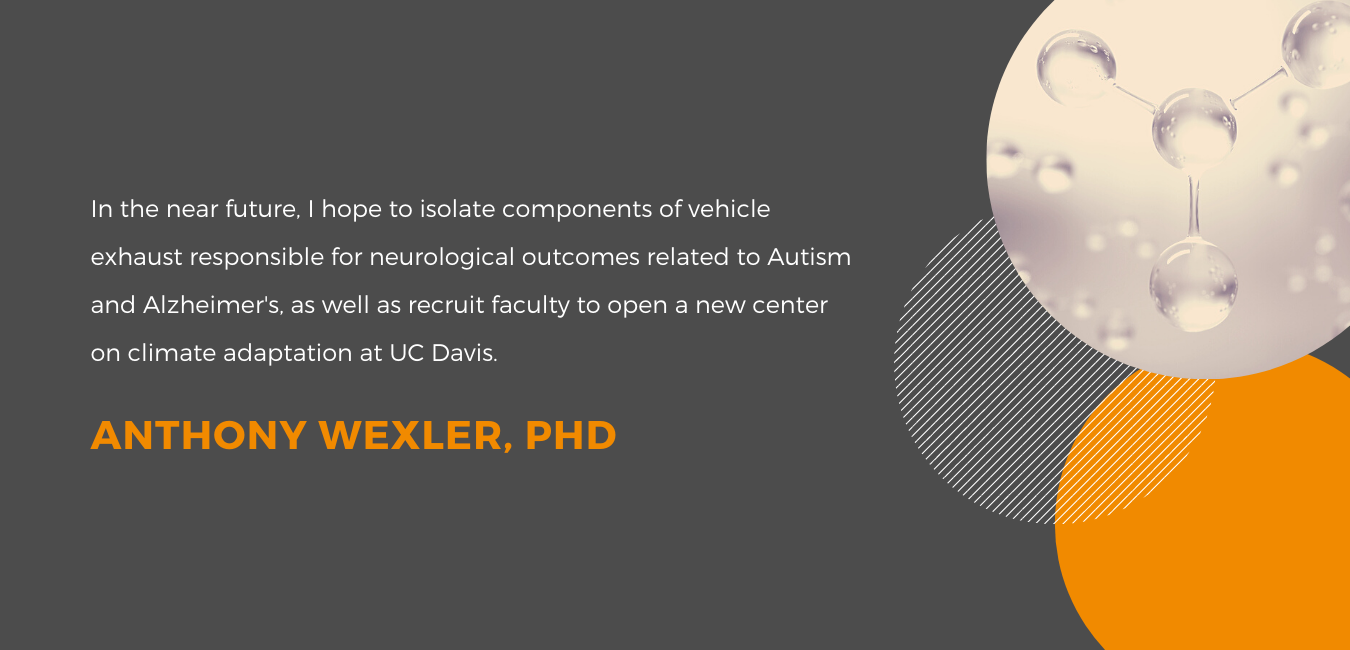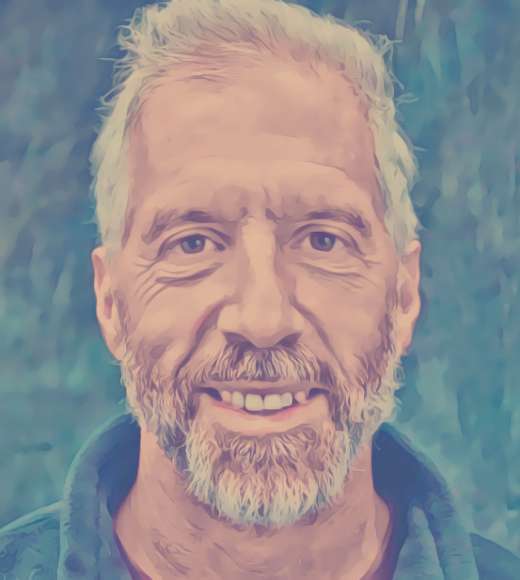

Anthony Wexler, PhD, MS is a research scientist who measures and models atmospheric aerosols related to urban smog, human health and global warming. His engineering background is the foundation for his understanding of the body’s physiological systems.
Dr. Wexler’s work focuses on the ways air pollution travels through the atmosphere to airways and affects different parts of the body. He uses experiments, crunches numbers and takes into account theories in physics to do his research.
The Extended Aerosol Inorganics Model (E-AIM) is among Dr. Wexler’s many innovative accomplishments, which he developed in collaboration with Dr. Simon Clegg at the University of East Anglia in the United Kingdom. This online model is the gold standard for aerosol thermodynamics and runs over 100,000 calculations each year for scientists worldwide.
More recently, Dr. Wexler has been working on two research projects with his colleagues Drs. Bein, Lein and Silverman at the Environmental Health Sciences Center at UC Davis. These projects are exploring the neurological health effects of near-roadway air pollution and examining possible connections to autism spectrum disorder and Alzheimer’s disease. Results from the autism and Alzheimer’s studies have uncovered some important clues that could someday help explain the higher prevalence of these conditions in people living near busy roadways.
In the autism experiment, rats exposed in real time to air pollution had behavioral and pathological effects suggesting development of the central nervous system was disrupted sometime around conception through six weeks after birth. In the Alzheimer’s experiment, wild-type (normal) and genetically predisposed rats exposed to air pollution for 15 months showed behaviors and pathology also suggesting a relationship to the disease.
These studies and hundreds of others Dr. Wexler has published over his expansive career makes him one of the world’s leading thinkers on the impact air pollution has on human health. He also holds five patents related to his research, and is a fellow of the American Association for Aerosol Research.
Contact
Email: aswexler at ucdavis.edu
Phone: (530) 754-6558
Social media: Facebook, Twitter, Instagram, YouTube
Positions at UC Davis
Distinguished Professor, Mechanical and Aerospace Engineering
Distinguished Professor, Civil and Environmental Engineering
Distinguished Professor, Land, Air, and Water Resources
Director, Air Quality Research Center
Areas of expertise
- Aerosol science
- Air pollution
- Alzheimer’s disease
- Autism spectrum disorder
- Biomedical transport
- Climate adaptation
- Fluid mechanics
- Thermodynamics
- Wildfires
Dr. Wexler’s expertise is recognized worldwide. He’s a fellow of the American Association for Aerosol Research and is on the editorial board of Atmospheric Environment. He’s served on the board of several other prestigious journals, including Aerosol Science and Technology.
He’s a past President of the American Association of Aerosol Research, and has been an advisor on fine particulate research to the US Department of Energy, as well as international advisory chair at the Center for Excellence in Environmental Studies at King Abdulaziz University in Jeddah, Saudi Arabia.
Recent journal papers
Asadi S et al. 2019. Aerosol emission and superemission during human speech increase with voice loudness. Scientific Reports, volume 9, article number: 2348 https://www.nature.com/articles/s41598-019-38808-z
Takahama S et al. 2019. Atmospheric particulate matter characterization by Fourier Transform Infrared spectroscopy: A review of statistical calibration strategies for carbonaceous aerosol quantification in US measurement networks. Atmospheric Measurement Techniques, volume 12, issue 1, 525-567. https://www.atmos-meas-tech.net/12/525/2019/
Toribio AR et al. 2018. Statistical mechanics of multilayer sorption: Surface concentration modeling and XPS measurement. Journal of Physical Chemistry Letters 9:1461-1464. https://pubs.acs.org/doi/10.1021/acs.jpclett.8b00332
Islam A et al. 2017. Comparison of manual and automated measurements of tracheobronchial airway geometry in three balb/c mice. Anatomical Record, 300(11):2046-2057. https://www.ncbi.nlm.nih.gov/pubmed/28632922
Broche L et al. 2016. Dynamic mechanical interactions between neighboring airspaces determine cyclic opening and closure in injured lung. Acta Physiologica, 217:141. https://onlinelibrary.wiley.com/doi/epdf/10.1111/apha.12712
Cappa CD et al. 2016. Simulating secondary organic aerosol in a regional air quality model using the statistical oxidation model – Part 2: Assessing the influence of vapor wall losses. Atmospheric Chemistry and Physics, 16:3041-3059. https://www.atmos-chem-phys.net/16/3041/2016/
Jathar SH et al. 2016. Simulating secondary organic aerosol in a regional air quality model using the statistical oxidation model, Part 1: Assessing the influence of constrained multi-generational ageing. Atmospheric Chemistry and Physics, 16:2309-2322. https://www.atmos-chem-phys.net/16/2309/2016/
Bein KJ et al. 2015. Retrospective source attribution for source-oriented sampling and toxicity. Atmospheric Environment, 119:228-239. https://doi.org/10.1016/j.atmosenv.2015.08.051
Plummer LE et al. 2015. Pulmonary inflammatory effects of source-oriented particulate matter from California’s San Joaquin Valley. Atmospheric Environment, 119:174-181. https://www.ncbi.nlm.nih.gov/pmc/articles/PMC4639935/
Jathar SH et al. 2015. Multi-generational oxidation model to simulate secondary organic aerosol in a 3D air quality model. Geoscientific Model Development, 8:2553-2567. https://www.geosci-model-dev.net/8/2553/2015/
Javed W et al. 2015. Spatial, temporal and size distribution of particulate matter and its chemical constituents in Faisalabad, Pakistan. Atmósfera, volume 28, issue 1:99-116. https://www.sciencedirect.com/science/article/pii/S0187623615300035
Bein KJ et al. 2015. Compositional variance in extracted particulate matter using different filter extraction techniques. Atmospheric Environment, volume 107:24-34. https://www.sciencedirect.com/science/article/pii/S1352231015001454
Carosino CM et al. 2015. Allergic airway inflammation is differentially exacerbated by temporal and seasonal ambient particles: Heme oxygenase-1 as an acute biomarker. Journal of Toxicology and Environmental Health, Part A, 78:254-266. https://www.ncbi.nlm.nih.gov/pubmed/25679046
Charrier, JG et al. 2015. Oxidant production from source-oriented particulate matter Part 1: Oxidative potential using the dithiothreitol (DTT) assay. Atmospheric Chemistry and Physics, 15:2327-2340. https://www.atmos-chem-phys.net/15/2327/2015/
Van Winkle LS et al. 2015. Biological dose response to PM2.5: Effect of particle extraction method on platelet and lung responses. Toxicological Sciences. Feb;143(2):349-59.. https://www.ncbi.nlm.nih.gov/pubmed/25389146
Bein KJ et al. 2014. A high-efficiency, low-bias method for extracting particulate matter from filter and impactor substrates. Atmospheric Environment, 90:87-95. https://www.sciencedirect.com/science/article/pii/S1352231014002271
Lee DY et al. 2013. Atmospheric Amines – Part III: Photochemistry and Toxicity. Atmospheric Environment. 10.1016/j.atmosenv.2013.01.058, 75:95-103. https://www.sciencedirect.com/science/article/pii/S1352231013000836
Honors
- Chair, Haagen-Smit Prize Committee, Atmospheric Environment (2013 to 2016)
- Fellow, American Association for Aerosol Research (2011)
- Outstanding Mid-career Research Faculty Award, College of Engineering, UC Davis (2005)
- Plenary Lecturer, American Association for Aerosol Research Conference (1998)
- Dean’s Special Merit Award, University of Delaware (1991 to 1998)
- Editor’s Citation for Excellence in Refereeing for Journal of Geophysical Research, Atmospheres, American Geophysical Union (1997)
- Dean’s Teaching Commendation, University of Delaware (1993 and 1996)
- Kenneth T. Whitby Award, American Association for Aerosol Research (1995)
- Provost’s Special Merit Award, University of Delaware (1993, 1996 and 1999)
- Rockwell Scholarship (1989)
Video archive
Waking Up to Wildfires: Solving a terrible problem, Anthony Wexler in a clip from the documentary about the 2017 North Bay wildfires
California wildfires: The new normal, ABC10, November 8, 2018.
Smoke from wildfires is causing problems with air quality, ABC10 interview, October 11, 2017.
Wood Smoke and your Health: The Dangers of Particle Pollution in Sacramento, Sacramento Metropolitan Air Quality Management District, December 3, 2014.
Education
- PhD, Mechanical Engineering, California Institute of Technology (1990)
- MS, Mechanical Engineering. Massachusetts Institute of Technology (1978)
- BS, Engineering Physics, University of California, Berkeley (1976)
